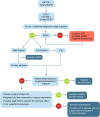Intraoperative circulatory arrest secondary to high-risk pulmonary embolism. Case series and updated literature review
- PMID: 38110877
- PMCID: PMC10726619
- DOI: 10.1186/s12871-023-02370-z
Intraoperative circulatory arrest secondary to high-risk pulmonary embolism. Case series and updated literature review
Abstract
Background: Intraoperative pulmonary embolism (PE) with cardiac arrest (CA) represents a critical and potentially fatal condition. Available treatments include systemic thrombolysis, catheter-based thrombus fragmentation or aspiration, and surgical embolectomy. However, limited studies are focused on the optimal treatment choice for this critical condition. We present a case series and an updated review of the management of intraoperative CA secondary to PE.
Methods: A retrospective review of patients who developed high-risk intraoperative PE was performed between June 2012 and June 2022. For the updated review, a literature search on PubMed and Scopus was conducted which resulted in the inclusion of a total of 46 articles.
Results: A total of 196 174 major non-cardiac surgeries were performed between 2012 and 2022. Eight cases of intraoperative CA secondary to high-risk PE were identified. We found a mortality rate of 75%. Anticoagulation therapy was administered to one patient (12.5%), while two patients (25%) underwent thrombolysis, and one case (12.5%) underwent mechanical thrombectomy combined with thrombus aspiration. Based on the literature review and our 10-year experience, we propose an algorithm for the management of intraoperative CA caused by PE.
Conclusion: The essential components for adequate management of intraoperative PE with CA include hemodynamic support, cardiopulmonary resuscitation, and the implementation of a primary perfusion intervention. The prompt identification of the criteria for each specific treatment modality, guided by the individual patient's characteristics, is necessary for an optimal approach.
Keywords: Anticoagulation; Cardiac Arrest; High-risk; Intraoperative; Pulmonary Embolism; Thrombolysis. Surgical embolectomy.
© 2023. The Author(s).
Conflict of interest statement
The authors declare no competing interests.
None.
Figures


Similar articles
-
Clinical outcomes of acute pulmonary embolectomy as the first-line treatment for massive and submassive pulmonary embolism: a single-centre study in China.J Cardiothorac Surg. 2020 Oct 21;15(1):321. doi: 10.1186/s13019-020-01364-z. J Cardiothorac Surg. 2020. PMID: 33087152 Free PMC article.
-
Successful thrombolytic therapy of post-operative massive pulmonary embolism after ultralong cardiopulmonary resuscitation: a case report and review of literature.Clin Respir J. 2017 May;11(3):383-390. doi: 10.1111/crj.12332. Epub 2015 Jul 24. Clin Respir J. 2017. PMID: 26083151 Review.
-
Combined clot fragmentation and aspiration in patients with acute pulmonary embolism.Chest. 2008 Jul;134(1):54-60. doi: 10.1378/chest.07-2656. Epub 2008 Jan 15. Chest. 2008. PMID: 18198243
-
Interventional Treatment of Pulmonary Embolism.Circ Cardiovasc Interv. 2017 Feb;10(2):e004345. doi: 10.1161/CIRCINTERVENTIONS.116.004345. Circ Cardiovasc Interv. 2017. PMID: 28213377 Review.
-
Catheter-directed embolectomy, fragmentation, and thrombolysis for the treatment of massive pulmonary embolism after failure of systemic thrombolysis.Chest. 2008 Aug;134(2):250-254. doi: 10.1378/chest.07-2846. Chest. 2008. PMID: 18682455
References
-
- Chicangana G, Zapata L, Gómez JC, Zuluaga JP. Trombólisis sistémica exitosa en un paciente con tromboembolismo pulmonar masivo, luego de reanimación cardiocerebropulmonar prolongada. Informe De Caso. Revista Colombiana De Anestesiologia. 2016;44:246–9. doi: 10.1016/j.rca.2016.02.001. - DOI
Publication types
MeSH terms
LinkOut - more resources
Full Text Sources
Medical

